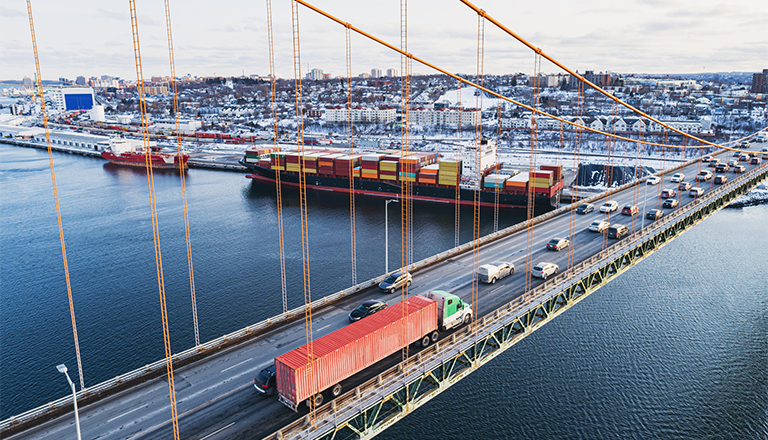Our four-part series on the benefits of exporting and strategies for success wraps up with a primer on international trade terms. With clear explanations of key trade terminology, you can make informed choices and manage the complexities of global trade.
If you work in international trade, it’s easy to get overwhelmed by acronyms and jargon—especially if you’re new to the game. To help you get started, here’s a primer on some of the most common international trade terms.
Understanding Incoterms 2020
Incoterms, short for international commercial terms, are standard rules that define the responsibilities of buyers and sellers during the shipping of goods. Set by the International Chamber of Commerce (ICC), these terms help reduce misunderstandings in global trade.
Incoterms can be roughly divided into three groups:
- Ex Works (EXW): The buyer pays all the shipping costs, which is ideal if you’re the exporter and you want to limit your risk responsibilities.
- Group C: The seller pays the main shipping costs, but the goods travel at the buyer’s risk.
- Group D: The seller pays all the shipping costs and assumes all shipping risks.
Export Development Canada’s (EDC) guide, Understanding Incoterms can prevent export challenges, provides an in-depth look at Incoterms.
You should also check out
Expand your understanding of the 11 universal trade terms used in global sales contracts and how they impact your business operations.
Shipping and export logistics terms for international trade
Shipping terms are essential for understanding the responsibilities and costs associated with transporting goods.
Freight forwarders

A company or individual that organizes the shipping and handling of goods for exporters. This includes:
- Documentation
- Customs clearance
- Negotiating freight rates
- Insurance
- Warehousing
- Transportation
- Shipment tracking
It’s key to look for international freight forwarders with expertise in your target market and industry-specific regulations. Organizations such as the Canadian International Freight Forwarders Association (CIFFA) regulate the industry and can connect you with freight companies in your area.
Customs brokers
These are government-licensed experts who make sure imported and exported goods comply with customs rules. Their responsibilities include:
- preparing customs documentation;
- classifying tariffs and calculate duties;
- making duty payments on behalf of clients; and
- providing guidance on tariffs, product value and country of origin.
The Canadian Society of Customs Brokers (CSCB) can connect you with an experienced customs broker.
Harmonized system (HS) code
HS codes are unique numbers used globally to classify products for trade. They’re essential for:
- Customs declarations: They’re used to accurately describe goods in customs documentation, facilitating the smooth processing of shipments across international borders.
- Determining tariffs: Assists in calculating the correct tariffs and duties to be applied to imported and exported goods. You can use HS codes to find out tariff information using the Canada Tariff Finder.
- Ensuring compliance: HS codes ensure that products comply with international trade regulations, helping you to avoid legal issues and penalties.
Shipping weights and volumes
There are a number of acronyms and trade terms when shipping goods internationally. Here are some of the most common:
Land shipments:
- TL/FTL (trailer load or full-trailer load): For larger shipments that fill a trailer
- LTL (less than a trailer load): For smaller shipments that don’t require a full trailer
Ocean shipments:
- FCL (full container load): For shipments that fill an entire container
- LCL (less than a container load): For smaller shipments where goods from multiple shippers are consolidated into one container
Cargo insurance
Cargo insurance protects your goods during transit. Different policies cover various risks, like theft or damage, and are classified into three types, known as institute cargo clauses A, B and C:
- Clause A: Covers all risks, including theft, damage and loss during transit. Ideal for high-value or sensitive goods
- Clause B: Less expensive and covers specific risks for mid-value goods
- Clause C: Least expensive and only covers major risks, like total loss of cargo
Carrier liability
This is the legal responsibility of a carrier for lost or damage to goods during transit. Liability limits vary by mode of transportation:
- Trucking in Canada: Maximum liability is $2 per pound of freight, or $4.41 per kilogram.
- Trucking in the U.S.: Maximum liability can be as low as 60 cents per pound.
- Air freight: Maximum liability depends on the nationality of the airline, generally between $30 and $35 per kilogram.
- Ocean freight: Liability varies, usually between $500 and $900 per container.
Note: These rates are current as of May 2025, but may change without notice.
ISPM 15
Short for International Standards for Phytosanitary Measures No. 15, this was developed by the International Plant Protection Convention (IPPC) and regulates wood packaging materials to prevent the spread of bugs. When Canadian businesses ship outside the U.S., the wood has to be heat-treated or fumigated and certified with a stamp. If you don’t use treated wood, your shipment will be rejected at its destination.
This only applies to non-manufactured wood—not plywood and chipboard. Canada and the U.S. have a mutual exemption on this, but it’s a good idea to know these rules in case things change.

Key documentation and reporting trade terms for exporters
Documentation and reporting requisitions are important for compliance and smooth international transactions.
Commercial invoice
This invoice serves as a record or bill of sale between an exporter and importer. It’s essential for customs clearance, providing necessary information for assessing import duties and taxes.
Tip: It’s good practice to also provide a packing list—it’s not always compulsory, but recommended.
Pro forma invoices
These are similar to commercial invoices, in terms of content, but are produced by a supplier before goods are shipped to a buyer. They don’t function as a request for payment—they could include samples at a trade show, for example. They’re used to ensure clarity and transparency between buyers and sellers and can be used to apply for credits and loans at financial institutions.
Bill of lading
A legal document issued by a carrier to acknowledge receipt of cargo for shipment. It serves as a receipt, a document of title and a contract for the transportation of goods. There are bill of lading templates that include essential information, like shipper and receiver names, goods description, weight and handling instructions.
Certificate of origin
Certifies that the goods being exported were produced, manufactured or processed in a specific country. This information is essential for determining applicable tariffs and ensuring compliance with trade regulations. It includes specific information, including:
- Certifier details
- Product description
- HS code
- Detailed product description
- Country of origin
- Applicable rules of origin
- Signature and date
There’s no global standard for a certificate of origin, but there are templates and guides for Canada’s major free trade agreements (FTAs).
Export declaration
A form sent to customs officials that describes the type, amount and value of goods being exported. It’s required for compliance with export regulations and for statistical data collection. Exporters are usually responsible for filling out the form, but freight forwarders or customs brokers can also handle this task.
Note: While previously a paper form, the Canadian Export Reporting System (CERS) has made it mandatory to declare all exports electronically.
Export permit
An export permit or licence is a government document authorizing the export of specific goods and technology. While not required for all exports, it’s mandatory for the legal export of controlled goods, or if you’re planning to sell to a country where Canada has imposed sanctions.
For example, if you want to export high-tech equipment to another country, you might need to get an export permit to ensure you’re allowed to sell those items and following all the necessary regulations.
Canada’s free trade agreements and related terms
Understanding free trade agreements (FTAs), tariffs and related trade terms can help you make the most of international opportunities.
Tariff
A tariff is a tax imposed by a government on imported or exported goods. For example, Canada might impose a 10% tax on imports from another country. Canadian businesses importing or exporting goods need to understand how tariffs work to comply with trade regulations and set competitive prices for their goods.
Preferential tariffs
Preferential tariffs lower taxes on goods traded between countries with an FTA. These tariffs reduce costs, promote trade and offer benefits beyond standard MFN rates. For example, if a Canadian company is exporting their product to a country that has an FTA with Canada, the product might have a reduced tariff rate or no tariff at all.
For additional insights into managing preferential tariffs and customs compliance, check out EDC’s webinar, Navigating tariffs and customs regulations.
Non-tariff barriers (NTBs)
NTBs are rules and regulations, other than tariffs, that limit trade. They include:
- Quotas: Limits set by a country on how much of a specific product can be imported or exported during a specific time period.
- Embargoes: Official bans on trade with specific countries, often for political or economic reasons.
- Sanctions: Restrictions imposed by one country on another to influence political or economic behaviour. These include trade restrictions, asset freezes and travel bans.
Other NTBs include health and safety standards, environmental regulations and labelling requirements for imported goods.
Free trade agreement (FTA)
An FTA is a contract between countries that sets trade rules, lowers taxes on goods, simplifies customs and creates business opportunities. FTAs also protect intellectual property, improve working conditions and environmental standards, and encourage investment.
Canada has 15 FTAs that remove barriers to trade with 51 different countries, giving Canadian businesses a competitive edge over companies from non-FTA countries.
CETA
The Canada-European Union (EU) Comprehensive Economic Trade Agreement (CETA) removes 98% of the tariffs between Canada and the EU, giving Canadian businesses preferential access to one of the world’s largest markets.
CUSMA
CUSMA stands for the Canada-United States-Mexico Agreement, a pivotal FTA for Canadian businesses. Despite trade policy changes in 2025, CUSMA continues to provide duty-free access for qualifying goods, enhancing market access for Canadian exporters.
CPTPP
The Comprehensive and Progressive Agreement for Trans-Pacific Partnership (CPTPP) provides Canadian businesses access to 11 other countries, representing more than 580 million consumers and providing opportunities for export diversification.
Most favoured nation (MFN):
MFN is a World Trade Organization (WTO) rule that ensures equal trade treatment for all members. If one country gets better terms—like lower tariffs—all members must receive the same benefits. MFN status improves market access and competitiveness, promoting fairness and predictability in international trade.
Rules of origin
Rules of origin are criteria used to determine where a product or service was made and if it qualifies for preferential tariff rates. These rules differ from country to country and are usually detailed in an FTA. For Canadian exporters, understanding and complying with rules of origin helps ensure their goods qualify for lower tariffs under FTAs.
For example, Canadian goods that comply with CUSMA rules of origin can avoid tariffs when exported to the U.S. or Mexico. This makes Canadian products more competitive in those markets.
Payment methods in international trade
Common payment terms you should know to select the right payment method for your exports and manage risk.
Cash in advance
Cash in advance is when the buyer pays the seller in cash before receiving the shipment, often before shipment is made. This method removes the risk of non-payment for the seller, but can be risky for the buyer. It’s a common international trade payment method usually done through wire transfers, online payment portals, credit cards, debit cards, or bank accounts.
Letters of credit
A guarantee from one bank to another (usually in a different country) ensuring payments will be made on time and for the correct amount. With a letter of credit from your buyer, you can ensure you’ll get paid, as long as you provide all the required documents to the bank.
Note: If you’re dealing with a country with an unstable banking system, the letter of credit should be confirmed by a Canadian bank to ensure payment.
Letters of credit can tie up your working capital, limiting your business growth. EDC’s Account Performance Security Guarantee (APSG) works with your financial institution to provide a 100% guarantee for standby letters of credit, freeing up your cash or credit line, so you can seek out new opportunities.
Documentary collection
This is a trade finance tool where an exporter gets paid by an importer after their banks exchange the necessary documents. This method is less secure, but less expensive than letters of credit. Banks act as intermediaries for the documents, but don’t guarantee payment.
Open account
An open account is a payment method that allows goods to be shipped and received before payment is made, typically within 30, 60, or 90 days. This can help the importer manage cash flow, but is risky for the exporter.
Tip: Exporters can reduce the risk of non-payment by using trade finance solutions such as EDC’s trade credit insurance, which covers a specified amount of insured receivables if the buyer doesn’t pay.
Consignment
Consignment is when goods are sent to a foreign distributor who sells them for the exporter. The exporter keeps ownership of the goods until they’re sold and only gets paid for sold items. This method allows exporters to deliver goods quickly, reduce storage costs and keep prices competitive.
It does carry high risk, as payment isn’t guaranteed. Carefully reviewing consignment terms will help manage inventory and delivery schedules.
Credit insurance
Credit insurance covers the money you’re owed from sales to your international buyer. If your customer can’t or won’t pay, credit insurance will cover a specified amount of the insured receivables owed.
EDC offers trade credit insurance solutions, which cover up to 90% of your insured losses against the risk of non-payment.
Exchange rate
An exchange rate is the value of one currency when it’s exchanged for another. For example, if the exchange rate between Canadian and U.S. dollars is 1 to 0.72, that means one Canadian dollar is worth 72 cents American. Factors, like trade, investment, tourism and geopolitical risks, can affect currency values.
Understanding foreign exchange rates is important for protecting profits from currency fluctuations and managing international transactions. Hedging tools such as EDC’s Foreign Exchange Facility Guarantee (FXG) can help manage currency exchange risk without tying up cash.
Expand your trade knowledge with EDC
Whether you’re learning new trade terminology, or trying to find answers to trade-related questions, EDC can help. Create a free MyEDC account to access guides, articles and the Export Help Hub, where you’ll find answers to more than 1,000 frequently asked questions. You can also ask an advisor a question of your own.
This content was partially created using generative artificial intelligence (GenAI).






